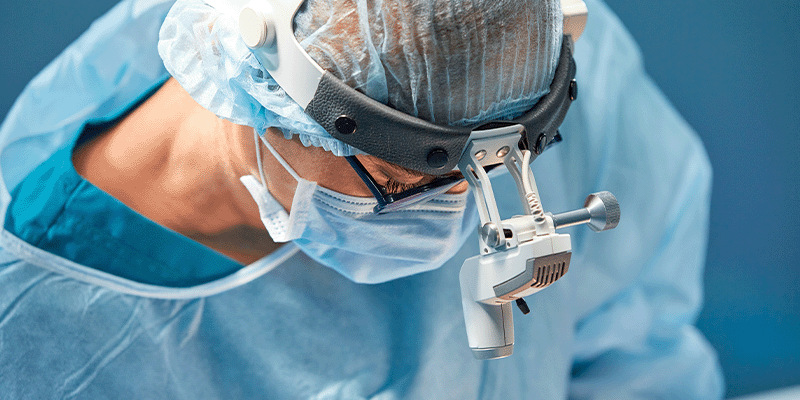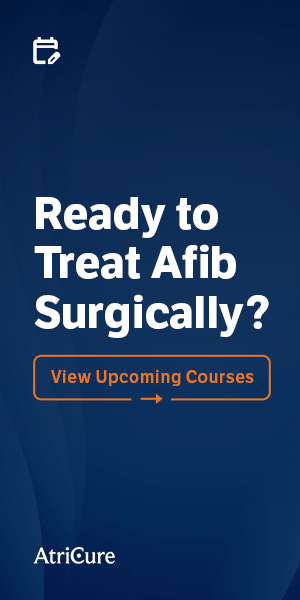Normal Sinus Rhythm: How Breaking the Afib Cycle Can Be The Best Chance at a Normal Life

The critical importance of timing, technique, and teamwork in Afib intervention
Atrial fibrillation (Afib) is more than a rhythm disorder—it's a progressive disease that, if left untreated, can lead to heart failure, stroke, and diminished quality of life.1-2 For healthcare providers, the question isn't whether to treat Afib, but when and how to intervene for the best outcomes.
Early Intervention: A Window of Opportunity
The longer Afib persists, the harder it becomes to reverse. Structural and electrical remodeling of the atria makes rhythm control increasingly difficult.3-4 That's why early intervention—especially during cardiac surgery—is essential. For patients already in the OR, surgical ablation offers a unique opportunity to restore rhythm without additional procedures. However, Afib remains surgically undertreated.5
Why Sinus Rhythm Matters: The Life-Changing Impact of Normal Heart Rhythm
Restoring sinus rhythm isn't just about symptom relief—it's about fundamentally changing a patient's health trajectory and quality of life. The benefits of maintaining normal sinus rhythm extend far beyond what patients and even some physicians realize:
Immediate Physical Benefits:
Enhanced Cardiac Output and Exercise Capacity
- Normal atrial contraction contributes 15–30% of ventricular filling.6
- Patients experience improved exercise tolerance and reduced fatigue.7
- Better oxygen delivery to vital organs improves overall physical function.
Symptom Resolution
- Elimination of palpitations, chest discomfort, and irregular heartbeat sensations.
- Improved sleep quality as patients no longer wake from rhythm disturbances.
- Reduced anxiety related to unpredictable heart rhythm episodes.
Long-Term Health Outcomes:
Stroke Risk Reduction
- Organized atrial contraction reduces blood stasis and clot formation.8
- Even with continued anticoagulation, stroke risk decreases significantly.9
- Potential for anticoagulation discontinuation in some patients after successful rhythm restoration.10
Heart Failure Prevention
- Prevents the Afib-induced cardiomyopathy that leads to heart failure.11-12
- Maintains optimal ventricular filling and cardiac efficiency.
- Reduces hospitalizations for heart failure exacerbations.13
Survival Advantage
- Patients who spend more time in sinus rhythm experience fewer hospitalizations, improved functional capacity, and better long-term survival.14-15
- Studies show that restoring sinus rhythm during surgery can bring survival rates in line with patients who never had Afib.16
- Most importantly: successful rhythm restoration can put patients back on the same life-expectancy curve as if they never had Afib.17
42%
Higher survival at 1 year32
31%
Higher survival at 5 year33
20%
Higher survival at 10 year16
Quality of Life Transformation
- Patients regain the ability to perform daily activities without limitation.18
- Potentially return to recreational activities and hobbies previously restricted by symptoms.
- Improved cognitive function as brain perfusion stabilizes.19
The Progressive Nature of Untreated Afib
Without intervention, Afib creates a self-perpetuating cycle:
- Irregular rhythm leads to atrial remodeling.
- Structural changes make Afib more persistent.
- Heart function progressively deteriorates.
- Stroke risk continues to increase.
- Quality of life steadily declines.
Breaking this cycle through rhythm restoration halts disease progression and reverses many of these negative effects.
Surgical Ablation: The Gold Standard
Concomitant surgical ablation during cardiac surgery is a Class I recommendation.22 Performing the Cox-Maze IV procedure, the gold standard in surgical ablation, offers up to 90% freedom from Afib.23
Studies have shown that restoring sinus rhythm during surgery improves survival rates—bringing them in line with patients who never had Afib.16
Up to
90%
Freedom from Afib34-38
Up to
70%
Freedom from Afib39-40
LAA Exclusion: A Critical Complement
Excluding the left atrial appendage (LAA) has always been an important part of the Cox Maze IV procedure and is also recommended by all major medical societies for patients undergoing cardiac surgery.24-25 It reduces stroke risk and complements ablation by eliminating the primary source of thrombus formation. Despite its benefits, LAAE is underutilized—performed in fewer than 30% of eligible patients.26
Hybrid AF™ Therapy: For Patients Not Undergoing Surgery
For patients with long-standing persistent Afib, who are not candidates for structural heart surgery, Hybrid AF Therapy offers a minimally invasive, two-stage solution. This Class II recommended approach combines epicardial and endocardial ablation with LAAE, mimicking the Cox-Maze lesion set.27
Hybrid AF Therapy has demonstrated:
- 2x greater effectiveness in stopping atrial arrhythmias compared to catheter ablation alone.28
- 2x higher likelihood of eliminating the need for Afib medications.28
- Significant improvements in quality of life and symptom burden.29
Tailoring the Approach: Lesion Set Options to Fit Each Patient
Not all patients require a full Cox Maze IV lesion set. Depending on multiple variables, such as the underlying cardiac condition and type of Afib, surgeons can tailor the ablation strategy. There are options for cardiac surgeons that range from pulmonary vein isolation to a Box lesion set that isolates the left atrial posterior wall. However, efficacy increases with each additional lesion set, and the full Cox Maze IV remains the most effective.30
Post-Surgical Monitoring: The Role of Electrophysiology
After surgical ablation, rigorous follow-up is crucial. Electrophysiologists are best equipped to monitor patients (per Heart Rhythm Society guidelines), manage the 90-day blanking period, and perform touch-up ablations if needed.31 Without structured follow-up, patients can risk Afib recurrence and missed opportunities for optimization.
The Bottom Line: Treat Afib Like the Progressive Disease It Is
Afib is often dismissed as a nuisance arrhythmia, but the consequences of ignoring it in the operating room are serious. Whether through surgical ablation, Hybrid AF Therapy, or both, restoring sinus rhythm can dramatically improve survival, reduce stroke risk, and enhance quality of life.
The evidence is clear: patients deserve the opportunity to return to normal sinus rhythm and reclaim their lives.
It'll take collaboration and effort from everybody on the heart teams to shift the paradigm and treat Afib with the urgency and seriousness it deserves. Because when sinus rhythm is restored, lives are restored.
Dr. McCarthy discusses matching surgical ablation to the atrial fibrillation patient
PM-US-3773A-1025-G


